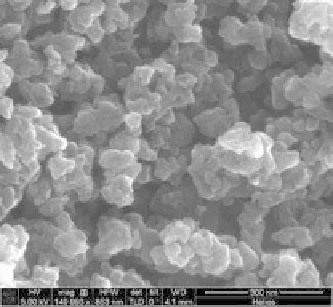Environmental Engineering Reference
In-Depth Information
FIGURE 2.2
Scanning electron micrograph of the surface of carbon produced by carbonization of a resorcinol/formaldehyde
(R/F: 0.5) resin. Polymerization is catalyzed by CO
3
Na
2
(catalyst/R: 0.005) in water (water/R: 10) using a stabi-
lizer ([PDAMAC] = 0.0013 M). The resin is carbonized at 800°C in an Ar atmosphere.
depending on the iber size) but also stabilizes the micropores/mesopores likely by surface
tension effects [98].
In that way, a spontaneous hierarchical carbon material (bearing mac-
ropores and mesopores) could be produced (Scheme 2.4).
The holes in the cloth and space between microibrils give macropores to the material (Figure
2.3), while the stabilization of nanoparticles by the ibers gives nanopores to the material.
On the other hand, hydrophobic polymer ibers can be inserted inside the RF to produce
long macropores to produce hierarchical carbon [99], using PDAMAC as a stabilizer of
nanoporosity.
2.2.1.4 Use of Hard Template (Silica Nanoparticles) to
Produce Hierarchical Porous Carbon
Porous carbon can be obtained using templates of nanoscale sizes [100,101]. Hierarchical
porous carbon (HPC) [102-104] can be obtained using two templates in a somewhat complex
process. On the other hand, we have recently shown that the volume contraction of the car-
bon around a remaining hard template during pyrolysis induces the formation of additional
mesoporosity, and, besides the pores deined by the hard template, is able to create a hierar-
chical carbon material [105].
In that way, HPC can be obtained in a single pyrolysis step. Since
Macropores
Nanopores
Impregnation
with resin
Carbonization
SCHEME 2.4
Synthesis of a hierarchical porous carbon (HPC-f) by carbonization of a cellulose cloth impregnated with RF
resin.





















































